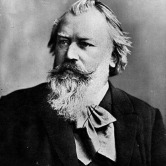

小简介
约翰内斯·勃拉姆斯(Johannes Brahms,1833-1897),德国古典主义最后的作曲家,出身于汉堡的一个音乐家庭。早年曾从戈赛尔、马克逊学钢琴,一生交游颇广,尤其得到舒曼夫妇及约·阿希姆赏识与支持,是创作与演奏并重的作曲家。勃拉姆斯的作品兼有古典手法和浪漫精神,极少采用标题,交响作品中模仿贝多芬的气势宏大,然而笔法工细,情绪变化多端,时有牧歌气...
他的大部分创作时期是在维也纳度过的,是维也纳的音乐领袖人物。他被一些评论家将其与巴赫、贝多芬排列在一起称为三B。他对标题音乐与华格纳的乐剧形式不认同,而是走纯粹音乐路线。
勃拉姆斯创作许多钢琴曲、室内乐、交响乐及合唱曲。勃拉姆斯本身炫技钢琴家,首演过许多自己的作品。勃拉姆斯也和当时不少杰出的音乐家一起合作,包括钢琴演奏家克拉拉·舒曼以及小提琴演奏家约瑟夫·姚阿幸。勃拉姆斯的很多作品已成为现代音乐会的主要曲目之一。勃拉姆斯是不妥协的完美主义者,曾毁掉他的部份作品.也有一些未发表的作品。
The stature of Johannes Brahms among classical composers is well illustrated by his inclusion among the "Three Bs" triumvirate of Bach, Beethoven, and Brahms. Of all the major composers of the late Romantic era, Brahms was the one most attached to the Classical ideal as manifested in the music of Haydn, Mozart, and especially Beethoven; indeed, Hans von Bülow once characterized Brahms' Symphony No. 1 (1855-1876) as "Beethoven's Tenth." As a youth, Brahms was championed by Robert Schumann as music's greatest hope for the future; as a mature composer, Brahms became for conservative musical journalists the most potent symbol of musical tradition, a stalwart against the "degeneration" represented by the music of Wagner and his school. Brahms' symphonies, choral and vocal works, chamber music, and piano pieces are imbued with strong emotional feeling, yet take shape according to a thoroughly considered structural plan.
The son of a double bassist in the Hamburg Philharmonic Society, Brahms demonstrated great promise from the beginning. He began his musical career as a pianist, contributing to the family coffers as a teenager by playing in restaurants, taverns, and even brothels. Though by his early twenties he enjoyed associations with luminaries like violinists Eduard Reményi and Joseph Joachim, the friend and mentor who was most instrumental in advancing his career was Schumann, who all but adopted him and became his most ardent partisan, and their esteem was mutual. Following Schumann's death in 1856, Brahms became the closest confidant and lifelong friend of the composer's widow, pianist and composer Clara Wieck Schumann. After a life of spectacular musical triumphs and failed loves (the composer was involved in several romantic entanglements but never wed), Brahms died of liver cancer on April 3, 1897.
In every genre in which he composed, Brahms produced works that have become staples of the repertory. His most ambitious work, the German Requiem (1863-1867), is the composer's singular reinterpretation of an age-old form. The four symphonies -- lushly scored, grand in scope, and deeply expressive -- are cornerstones of the symphonic literature. Brahms' concertos are, similarly, in a monumental, quasi-symphonic vein: the two piano concertos (1856-1859 and 1881) and the Violin Concerto (1878) call for soloists with both considerable technical skill and stamina. His chamber music is among the most sophisticated and exquisitely crafted of the Romantic era; for but a single example, his works that incorporate the clarinet (e.g., the Trio in A minor, Op. 114 and the two Sonatas, Op. 120), an instrument largely overlooked by his contemporaries, remain unsurpassed. Though the piano sonata never held for Brahms the same appeal it had for Beethoven (Brahms wrote three to Beethoven's 32), he produced a voluminous body of music for the piano. He showed a particular affinity for variations -- notably, on themes of Schumann (1854), Handel (1861), and Paganini (1862-1863) -- and likewise produced a passel of national dances and character pieces such as ballades, intermezzi, and rhapsodies. Collectively, these constitute one of the essential bodies of work in the realm of nineteenth century keyboard music.